Gender and Popular Culture: Shaping Identities in Modern Society
VerifiedAdded on 2023/06/14
|9
|2760
|152
Essay
AI Summary
This essay examines the influence of popular culture on gender identities, exploring how cultural narratives, images, and ideas shape societal views on race, gender, ethnicity, and class. It discusses how traditional feminist perspectives analyze popular culture's role in patriarchal societies and its impact on women's identities. The essay contrasts representations of men and women, highlighting concepts like hegemonic masculinity and the historical misrepresentation of women in media. It further delves into gender stereotypes, communication styles, and the societal construction of gender roles, concluding that popular culture often inaccurately reflects the characteristics of men and women, reinforcing social guidelines that influence gender acceptance.
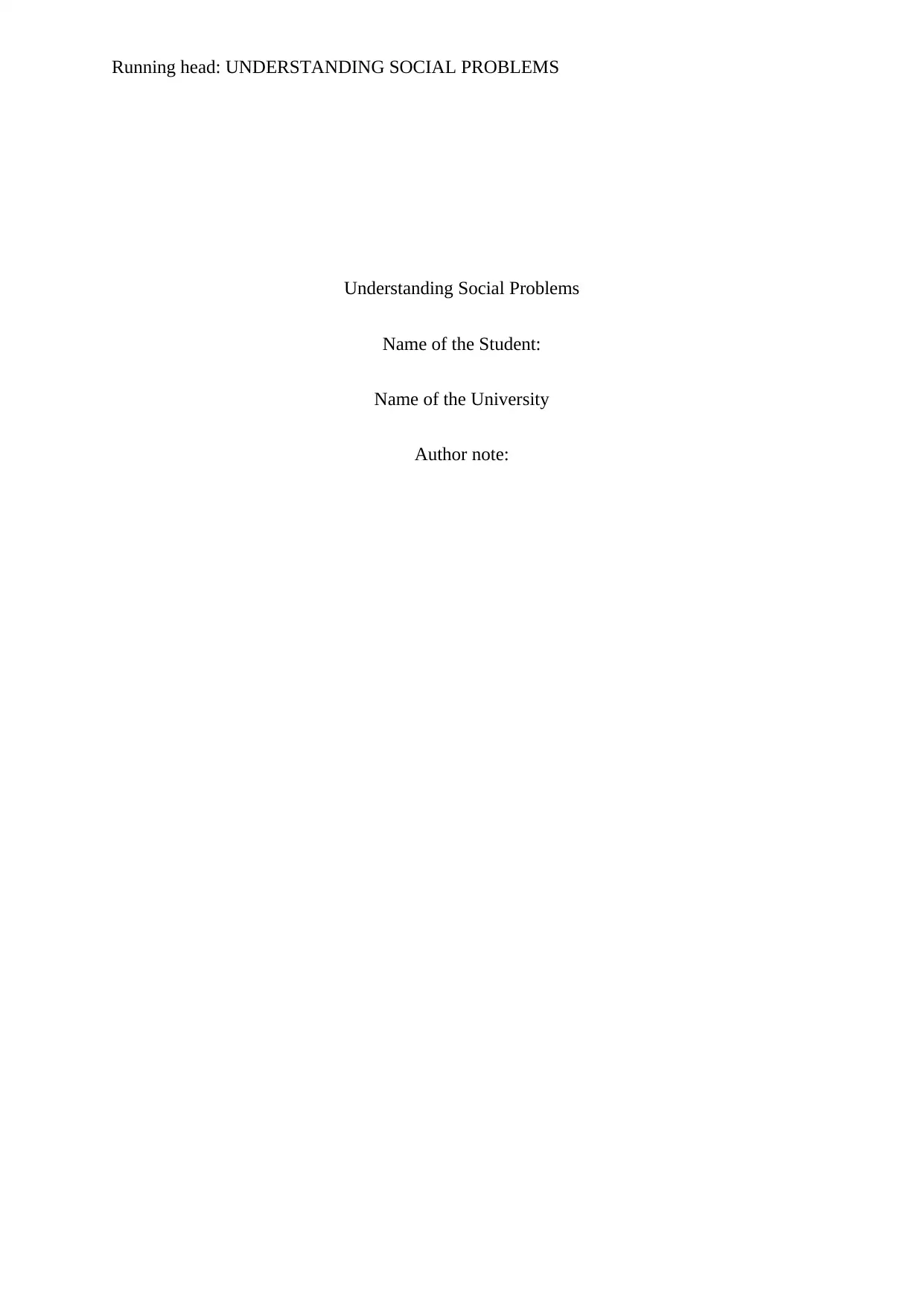
Running head: UNDERSTANDING SOCIAL PROBLEMS
Understanding Social Problems
Name of the Student:
Name of the University
Author note:
Understanding Social Problems
Name of the Student:
Name of the University
Author note:
Paraphrase This Document
Need a fresh take? Get an instant paraphrase of this document with our AI Paraphraser
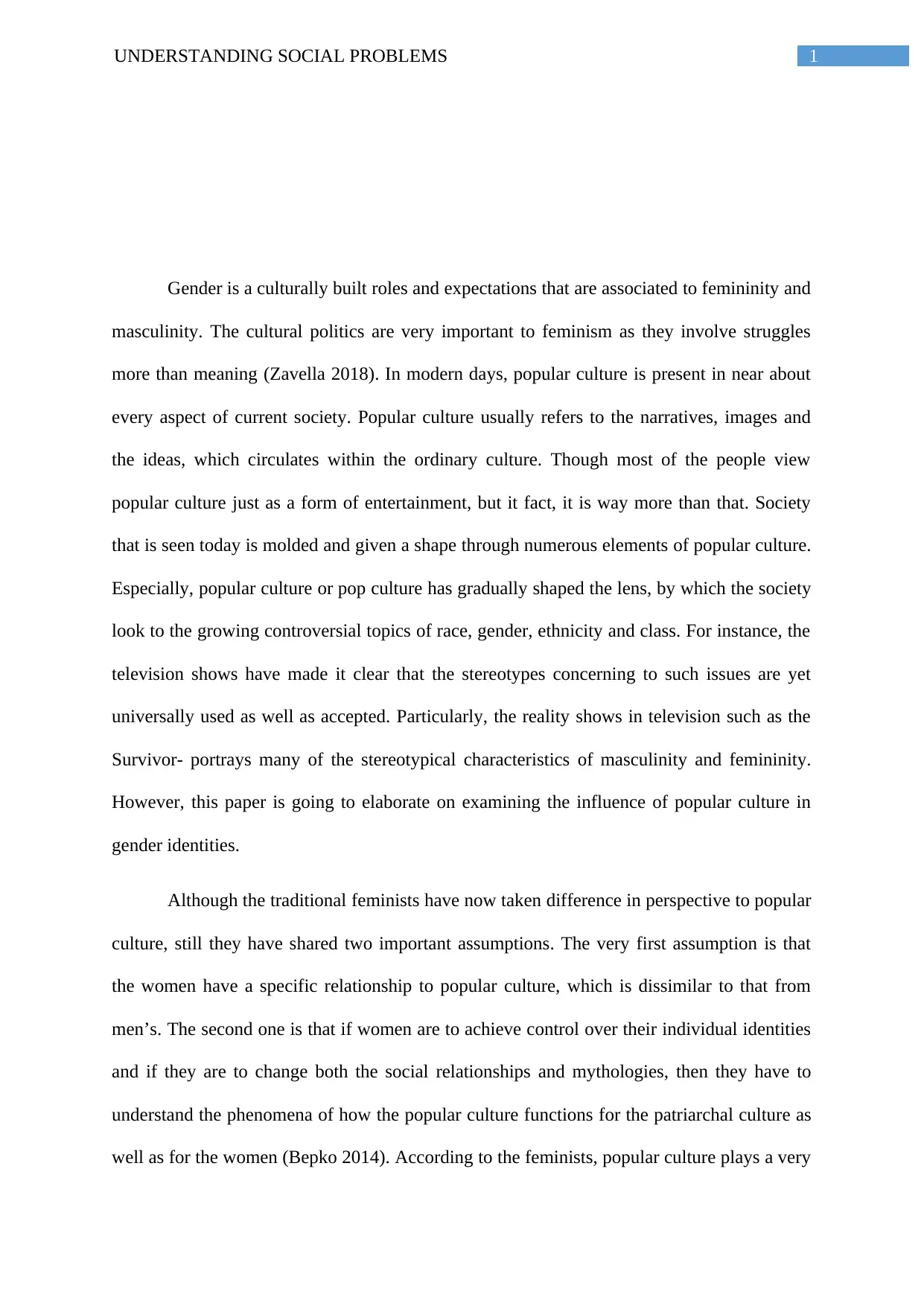
1UNDERSTANDING SOCIAL PROBLEMS
Gender is a culturally built roles and expectations that are associated to femininity and
masculinity. The cultural politics are very important to feminism as they involve struggles
more than meaning (Zavella 2018). In modern days, popular culture is present in near about
every aspect of current society. Popular culture usually refers to the narratives, images and
the ideas, which circulates within the ordinary culture. Though most of the people view
popular culture just as a form of entertainment, but it fact, it is way more than that. Society
that is seen today is molded and given a shape through numerous elements of popular culture.
Especially, popular culture or pop culture has gradually shaped the lens, by which the society
look to the growing controversial topics of race, gender, ethnicity and class. For instance, the
television shows have made it clear that the stereotypes concerning to such issues are yet
universally used as well as accepted. Particularly, the reality shows in television such as the
Survivor- portrays many of the stereotypical characteristics of masculinity and femininity.
However, this paper is going to elaborate on examining the influence of popular culture in
gender identities.
Although the traditional feminists have now taken difference in perspective to popular
culture, still they have shared two important assumptions. The very first assumption is that
the women have a specific relationship to popular culture, which is dissimilar to that from
men’s. The second one is that if women are to achieve control over their individual identities
and if they are to change both the social relationships and mythologies, then they have to
understand the phenomena of how the popular culture functions for the patriarchal culture as
well as for the women (Bepko 2014). According to the feminists, popular culture plays a very
Gender is a culturally built roles and expectations that are associated to femininity and
masculinity. The cultural politics are very important to feminism as they involve struggles
more than meaning (Zavella 2018). In modern days, popular culture is present in near about
every aspect of current society. Popular culture usually refers to the narratives, images and
the ideas, which circulates within the ordinary culture. Though most of the people view
popular culture just as a form of entertainment, but it fact, it is way more than that. Society
that is seen today is molded and given a shape through numerous elements of popular culture.
Especially, popular culture or pop culture has gradually shaped the lens, by which the society
look to the growing controversial topics of race, gender, ethnicity and class. For instance, the
television shows have made it clear that the stereotypes concerning to such issues are yet
universally used as well as accepted. Particularly, the reality shows in television such as the
Survivor- portrays many of the stereotypical characteristics of masculinity and femininity.
However, this paper is going to elaborate on examining the influence of popular culture in
gender identities.
Although the traditional feminists have now taken difference in perspective to popular
culture, still they have shared two important assumptions. The very first assumption is that
the women have a specific relationship to popular culture, which is dissimilar to that from
men’s. The second one is that if women are to achieve control over their individual identities
and if they are to change both the social relationships and mythologies, then they have to
understand the phenomena of how the popular culture functions for the patriarchal culture as
well as for the women (Bepko 2014). According to the feminists, popular culture plays a very
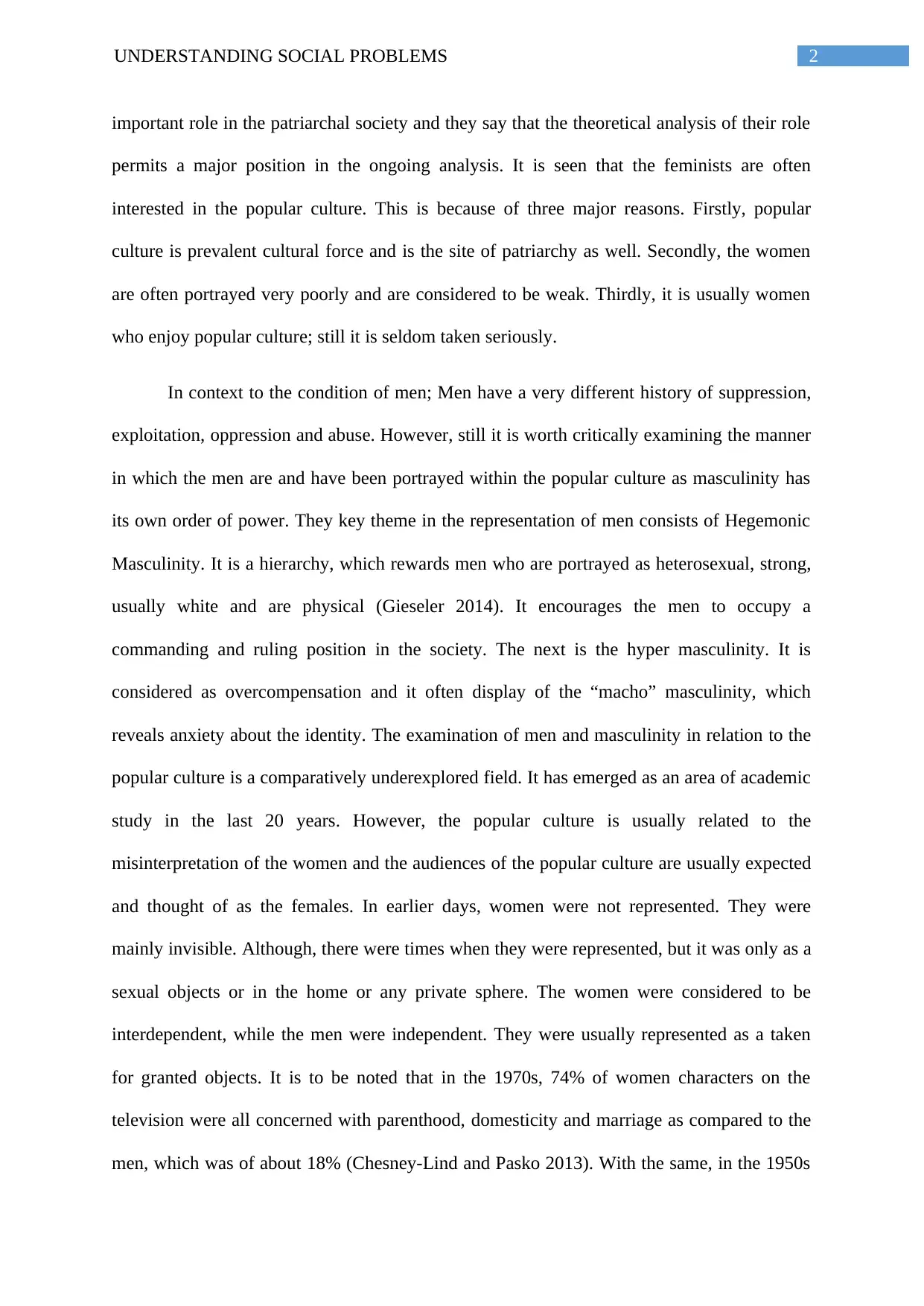
2UNDERSTANDING SOCIAL PROBLEMS
important role in the patriarchal society and they say that the theoretical analysis of their role
permits a major position in the ongoing analysis. It is seen that the feminists are often
interested in the popular culture. This is because of three major reasons. Firstly, popular
culture is prevalent cultural force and is the site of patriarchy as well. Secondly, the women
are often portrayed very poorly and are considered to be weak. Thirdly, it is usually women
who enjoy popular culture; still it is seldom taken seriously.
In context to the condition of men; Men have a very different history of suppression,
exploitation, oppression and abuse. However, still it is worth critically examining the manner
in which the men are and have been portrayed within the popular culture as masculinity has
its own order of power. They key theme in the representation of men consists of Hegemonic
Masculinity. It is a hierarchy, which rewards men who are portrayed as heterosexual, strong,
usually white and are physical (Gieseler 2014). It encourages the men to occupy a
commanding and ruling position in the society. The next is the hyper masculinity. It is
considered as overcompensation and it often display of the “macho” masculinity, which
reveals anxiety about the identity. The examination of men and masculinity in relation to the
popular culture is a comparatively underexplored field. It has emerged as an area of academic
study in the last 20 years. However, the popular culture is usually related to the
misinterpretation of the women and the audiences of the popular culture are usually expected
and thought of as the females. In earlier days, women were not represented. They were
mainly invisible. Although, there were times when they were represented, but it was only as a
sexual objects or in the home or any private sphere. The women were considered to be
interdependent, while the men were independent. They were usually represented as a taken
for granted objects. It is to be noted that in the 1970s, 74% of women characters on the
television were all concerned with parenthood, domesticity and marriage as compared to the
men, which was of about 18% (Chesney-Lind and Pasko 2013). With the same, in the 1950s
important role in the patriarchal society and they say that the theoretical analysis of their role
permits a major position in the ongoing analysis. It is seen that the feminists are often
interested in the popular culture. This is because of three major reasons. Firstly, popular
culture is prevalent cultural force and is the site of patriarchy as well. Secondly, the women
are often portrayed very poorly and are considered to be weak. Thirdly, it is usually women
who enjoy popular culture; still it is seldom taken seriously.
In context to the condition of men; Men have a very different history of suppression,
exploitation, oppression and abuse. However, still it is worth critically examining the manner
in which the men are and have been portrayed within the popular culture as masculinity has
its own order of power. They key theme in the representation of men consists of Hegemonic
Masculinity. It is a hierarchy, which rewards men who are portrayed as heterosexual, strong,
usually white and are physical (Gieseler 2014). It encourages the men to occupy a
commanding and ruling position in the society. The next is the hyper masculinity. It is
considered as overcompensation and it often display of the “macho” masculinity, which
reveals anxiety about the identity. The examination of men and masculinity in relation to the
popular culture is a comparatively underexplored field. It has emerged as an area of academic
study in the last 20 years. However, the popular culture is usually related to the
misinterpretation of the women and the audiences of the popular culture are usually expected
and thought of as the females. In earlier days, women were not represented. They were
mainly invisible. Although, there were times when they were represented, but it was only as a
sexual objects or in the home or any private sphere. The women were considered to be
interdependent, while the men were independent. They were usually represented as a taken
for granted objects. It is to be noted that in the 1970s, 74% of women characters on the
television were all concerned with parenthood, domesticity and marriage as compared to the
men, which was of about 18% (Chesney-Lind and Pasko 2013). With the same, in the 1950s
⊘ This is a preview!⊘
Do you want full access?
Subscribe today to unlock all pages.

Trusted by 1+ million students worldwide
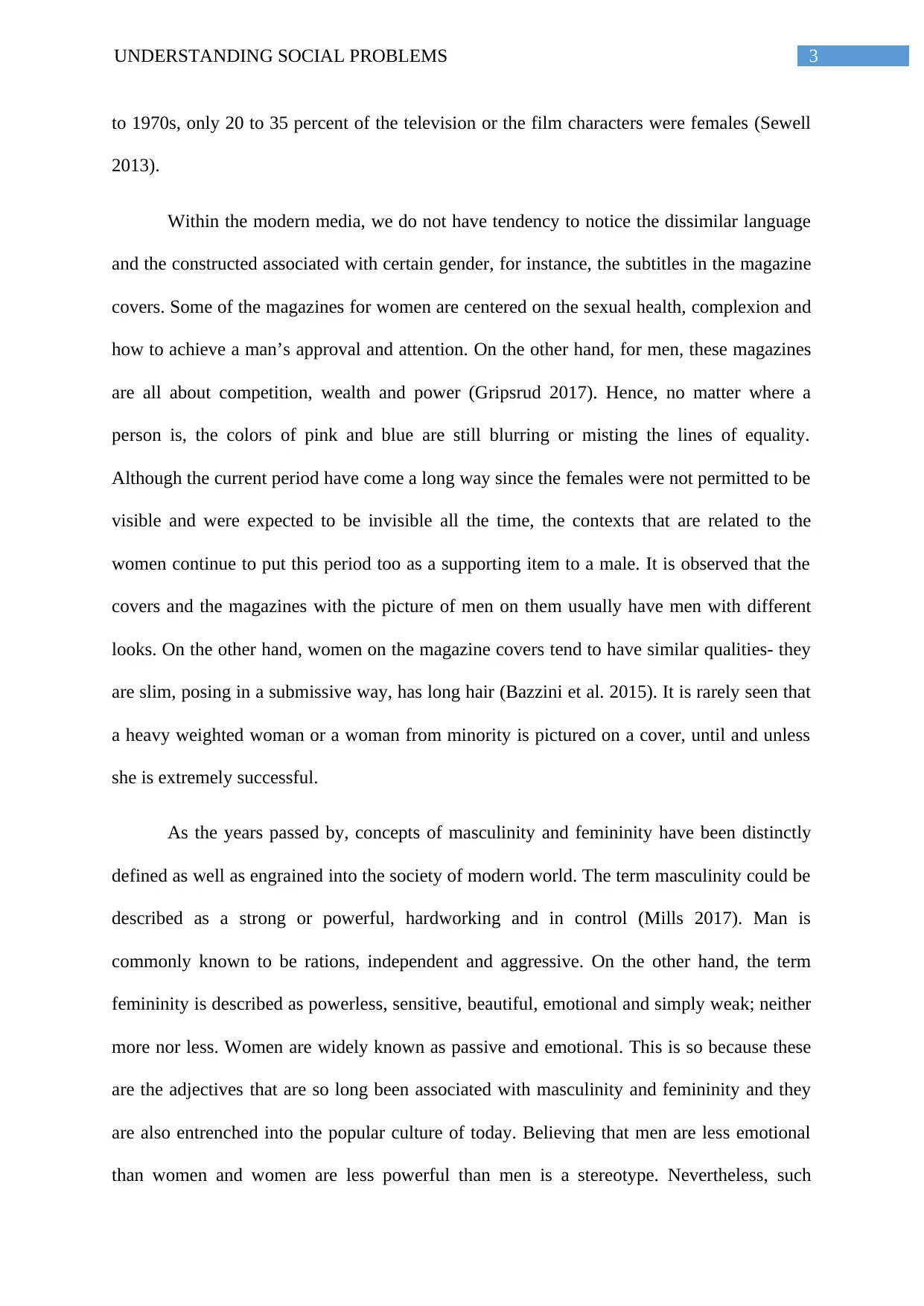
3UNDERSTANDING SOCIAL PROBLEMS
to 1970s, only 20 to 35 percent of the television or the film characters were females (Sewell
2013).
Within the modern media, we do not have tendency to notice the dissimilar language
and the constructed associated with certain gender, for instance, the subtitles in the magazine
covers. Some of the magazines for women are centered on the sexual health, complexion and
how to achieve a man’s approval and attention. On the other hand, for men, these magazines
are all about competition, wealth and power (Gripsrud 2017). Hence, no matter where a
person is, the colors of pink and blue are still blurring or misting the lines of equality.
Although the current period have come a long way since the females were not permitted to be
visible and were expected to be invisible all the time, the contexts that are related to the
women continue to put this period too as a supporting item to a male. It is observed that the
covers and the magazines with the picture of men on them usually have men with different
looks. On the other hand, women on the magazine covers tend to have similar qualities- they
are slim, posing in a submissive way, has long hair (Bazzini et al. 2015). It is rarely seen that
a heavy weighted woman or a woman from minority is pictured on a cover, until and unless
she is extremely successful.
As the years passed by, concepts of masculinity and femininity have been distinctly
defined as well as engrained into the society of modern world. The term masculinity could be
described as a strong or powerful, hardworking and in control (Mills 2017). Man is
commonly known to be rations, independent and aggressive. On the other hand, the term
femininity is described as powerless, sensitive, beautiful, emotional and simply weak; neither
more nor less. Women are widely known as passive and emotional. This is so because these
are the adjectives that are so long been associated with masculinity and femininity and they
are also entrenched into the popular culture of today. Believing that men are less emotional
than women and women are less powerful than men is a stereotype. Nevertheless, such
to 1970s, only 20 to 35 percent of the television or the film characters were females (Sewell
2013).
Within the modern media, we do not have tendency to notice the dissimilar language
and the constructed associated with certain gender, for instance, the subtitles in the magazine
covers. Some of the magazines for women are centered on the sexual health, complexion and
how to achieve a man’s approval and attention. On the other hand, for men, these magazines
are all about competition, wealth and power (Gripsrud 2017). Hence, no matter where a
person is, the colors of pink and blue are still blurring or misting the lines of equality.
Although the current period have come a long way since the females were not permitted to be
visible and were expected to be invisible all the time, the contexts that are related to the
women continue to put this period too as a supporting item to a male. It is observed that the
covers and the magazines with the picture of men on them usually have men with different
looks. On the other hand, women on the magazine covers tend to have similar qualities- they
are slim, posing in a submissive way, has long hair (Bazzini et al. 2015). It is rarely seen that
a heavy weighted woman or a woman from minority is pictured on a cover, until and unless
she is extremely successful.
As the years passed by, concepts of masculinity and femininity have been distinctly
defined as well as engrained into the society of modern world. The term masculinity could be
described as a strong or powerful, hardworking and in control (Mills 2017). Man is
commonly known to be rations, independent and aggressive. On the other hand, the term
femininity is described as powerless, sensitive, beautiful, emotional and simply weak; neither
more nor less. Women are widely known as passive and emotional. This is so because these
are the adjectives that are so long been associated with masculinity and femininity and they
are also entrenched into the popular culture of today. Believing that men are less emotional
than women and women are less powerful than men is a stereotype. Nevertheless, such
Paraphrase This Document
Need a fresh take? Get an instant paraphrase of this document with our AI Paraphraser
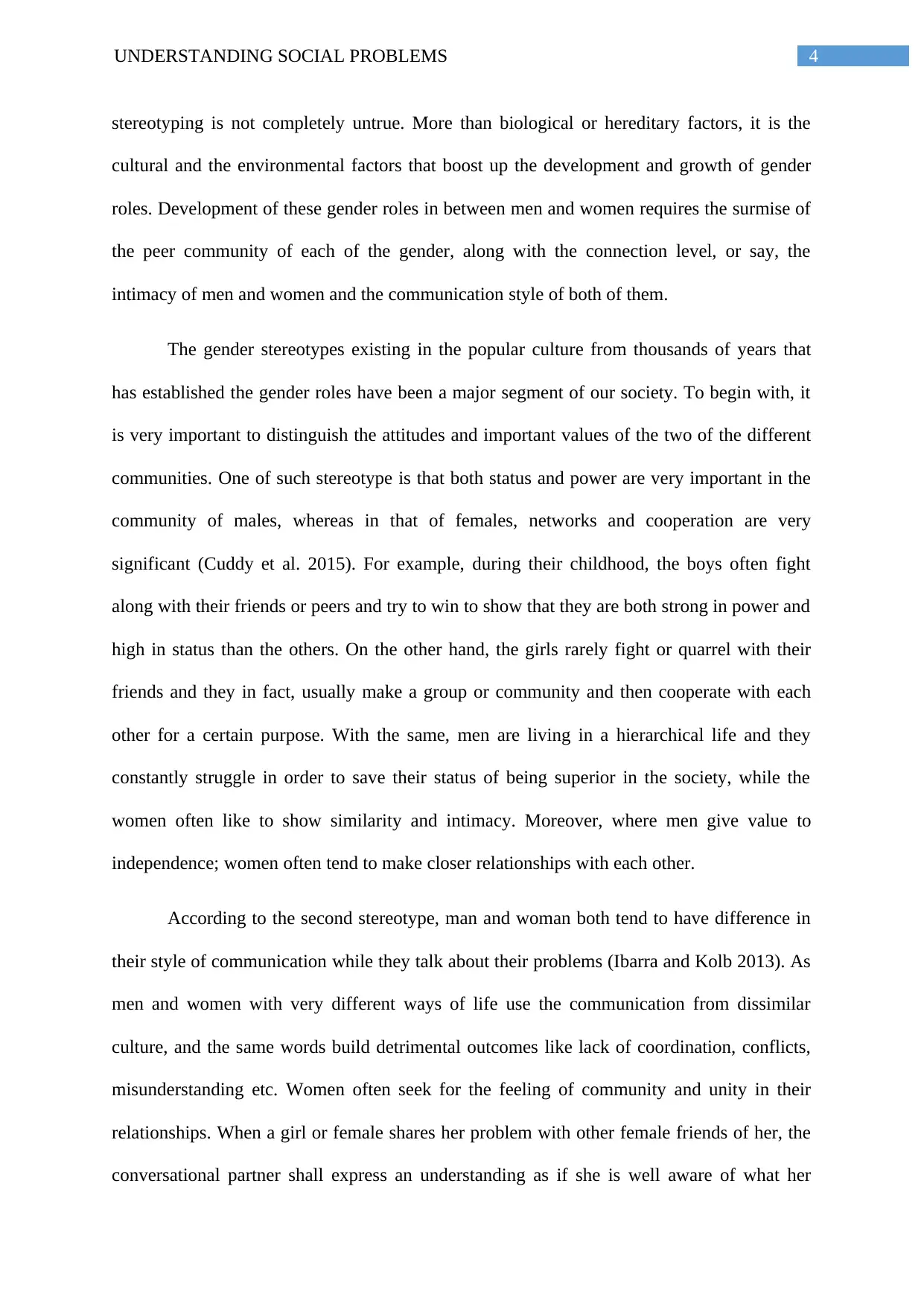
4UNDERSTANDING SOCIAL PROBLEMS
stereotyping is not completely untrue. More than biological or hereditary factors, it is the
cultural and the environmental factors that boost up the development and growth of gender
roles. Development of these gender roles in between men and women requires the surmise of
the peer community of each of the gender, along with the connection level, or say, the
intimacy of men and women and the communication style of both of them.
The gender stereotypes existing in the popular culture from thousands of years that
has established the gender roles have been a major segment of our society. To begin with, it
is very important to distinguish the attitudes and important values of the two of the different
communities. One of such stereotype is that both status and power are very important in the
community of males, whereas in that of females, networks and cooperation are very
significant (Cuddy et al. 2015). For example, during their childhood, the boys often fight
along with their friends or peers and try to win to show that they are both strong in power and
high in status than the others. On the other hand, the girls rarely fight or quarrel with their
friends and they in fact, usually make a group or community and then cooperate with each
other for a certain purpose. With the same, men are living in a hierarchical life and they
constantly struggle in order to save their status of being superior in the society, while the
women often like to show similarity and intimacy. Moreover, where men give value to
independence; women often tend to make closer relationships with each other.
According to the second stereotype, man and woman both tend to have difference in
their style of communication while they talk about their problems (Ibarra and Kolb 2013). As
men and women with very different ways of life use the communication from dissimilar
culture, and the same words build detrimental outcomes like lack of coordination, conflicts,
misunderstanding etc. Women often seek for the feeling of community and unity in their
relationships. When a girl or female shares her problem with other female friends of her, the
conversational partner shall express an understanding as if she is well aware of what her
stereotyping is not completely untrue. More than biological or hereditary factors, it is the
cultural and the environmental factors that boost up the development and growth of gender
roles. Development of these gender roles in between men and women requires the surmise of
the peer community of each of the gender, along with the connection level, or say, the
intimacy of men and women and the communication style of both of them.
The gender stereotypes existing in the popular culture from thousands of years that
has established the gender roles have been a major segment of our society. To begin with, it
is very important to distinguish the attitudes and important values of the two of the different
communities. One of such stereotype is that both status and power are very important in the
community of males, whereas in that of females, networks and cooperation are very
significant (Cuddy et al. 2015). For example, during their childhood, the boys often fight
along with their friends or peers and try to win to show that they are both strong in power and
high in status than the others. On the other hand, the girls rarely fight or quarrel with their
friends and they in fact, usually make a group or community and then cooperate with each
other for a certain purpose. With the same, men are living in a hierarchical life and they
constantly struggle in order to save their status of being superior in the society, while the
women often like to show similarity and intimacy. Moreover, where men give value to
independence; women often tend to make closer relationships with each other.
According to the second stereotype, man and woman both tend to have difference in
their style of communication while they talk about their problems (Ibarra and Kolb 2013). As
men and women with very different ways of life use the communication from dissimilar
culture, and the same words build detrimental outcomes like lack of coordination, conflicts,
misunderstanding etc. Women often seek for the feeling of community and unity in their
relationships. When a girl or female shares her problem with other female friends of her, the
conversational partner shall express an understanding as if she is well aware of what her
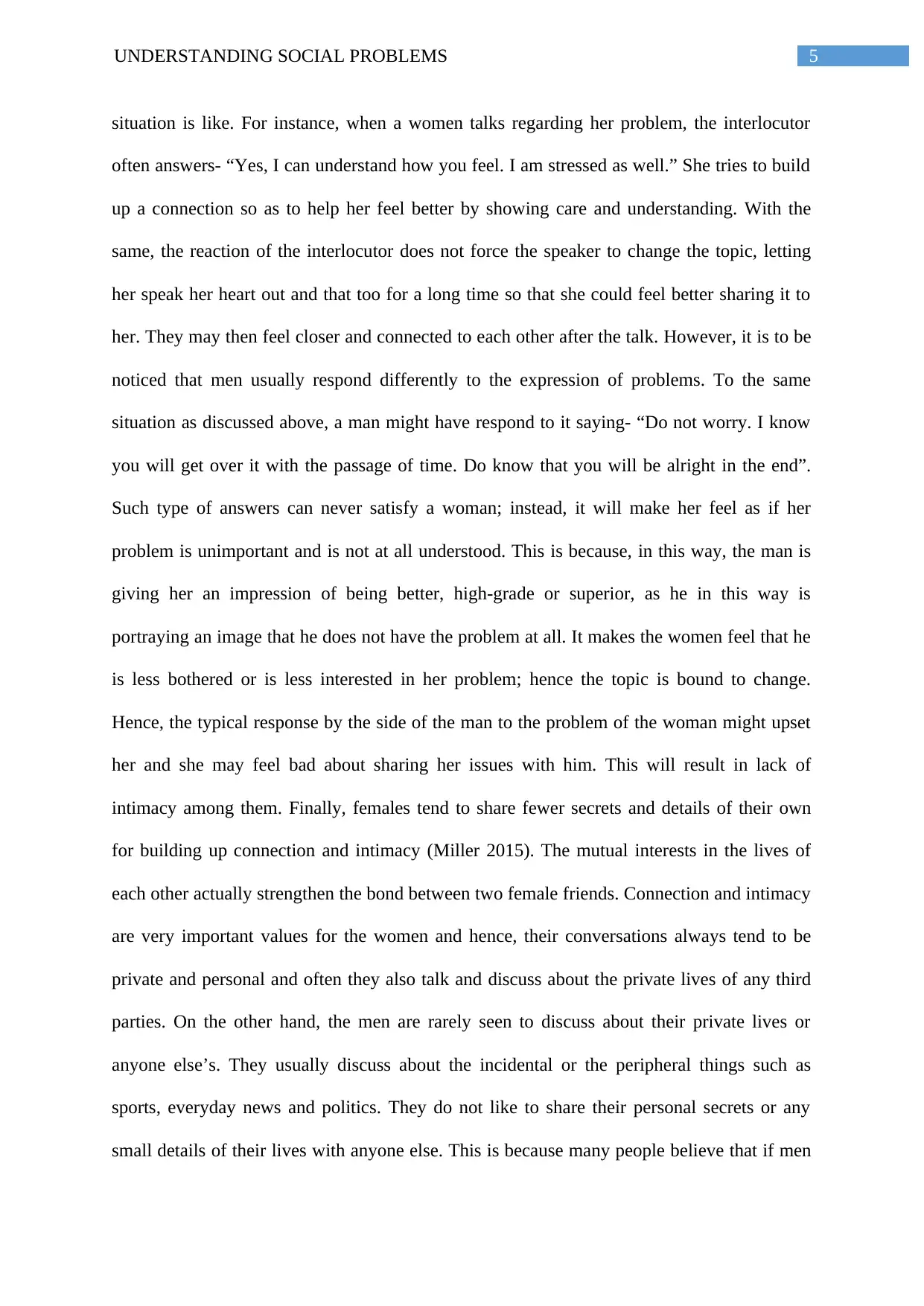
5UNDERSTANDING SOCIAL PROBLEMS
situation is like. For instance, when a women talks regarding her problem, the interlocutor
often answers- “Yes, I can understand how you feel. I am stressed as well.” She tries to build
up a connection so as to help her feel better by showing care and understanding. With the
same, the reaction of the interlocutor does not force the speaker to change the topic, letting
her speak her heart out and that too for a long time so that she could feel better sharing it to
her. They may then feel closer and connected to each other after the talk. However, it is to be
noticed that men usually respond differently to the expression of problems. To the same
situation as discussed above, a man might have respond to it saying- “Do not worry. I know
you will get over it with the passage of time. Do know that you will be alright in the end”.
Such type of answers can never satisfy a woman; instead, it will make her feel as if her
problem is unimportant and is not at all understood. This is because, in this way, the man is
giving her an impression of being better, high-grade or superior, as he in this way is
portraying an image that he does not have the problem at all. It makes the women feel that he
is less bothered or is less interested in her problem; hence the topic is bound to change.
Hence, the typical response by the side of the man to the problem of the woman might upset
her and she may feel bad about sharing her issues with him. This will result in lack of
intimacy among them. Finally, females tend to share fewer secrets and details of their own
for building up connection and intimacy (Miller 2015). The mutual interests in the lives of
each other actually strengthen the bond between two female friends. Connection and intimacy
are very important values for the women and hence, their conversations always tend to be
private and personal and often they also talk and discuss about the private lives of any third
parties. On the other hand, the men are rarely seen to discuss about their private lives or
anyone else’s. They usually discuss about the incidental or the peripheral things such as
sports, everyday news and politics. They do not like to share their personal secrets or any
small details of their lives with anyone else. This is because many people believe that if men
situation is like. For instance, when a women talks regarding her problem, the interlocutor
often answers- “Yes, I can understand how you feel. I am stressed as well.” She tries to build
up a connection so as to help her feel better by showing care and understanding. With the
same, the reaction of the interlocutor does not force the speaker to change the topic, letting
her speak her heart out and that too for a long time so that she could feel better sharing it to
her. They may then feel closer and connected to each other after the talk. However, it is to be
noticed that men usually respond differently to the expression of problems. To the same
situation as discussed above, a man might have respond to it saying- “Do not worry. I know
you will get over it with the passage of time. Do know that you will be alright in the end”.
Such type of answers can never satisfy a woman; instead, it will make her feel as if her
problem is unimportant and is not at all understood. This is because, in this way, the man is
giving her an impression of being better, high-grade or superior, as he in this way is
portraying an image that he does not have the problem at all. It makes the women feel that he
is less bothered or is less interested in her problem; hence the topic is bound to change.
Hence, the typical response by the side of the man to the problem of the woman might upset
her and she may feel bad about sharing her issues with him. This will result in lack of
intimacy among them. Finally, females tend to share fewer secrets and details of their own
for building up connection and intimacy (Miller 2015). The mutual interests in the lives of
each other actually strengthen the bond between two female friends. Connection and intimacy
are very important values for the women and hence, their conversations always tend to be
private and personal and often they also talk and discuss about the private lives of any third
parties. On the other hand, the men are rarely seen to discuss about their private lives or
anyone else’s. They usually discuss about the incidental or the peripheral things such as
sports, everyday news and politics. They do not like to share their personal secrets or any
small details of their lives with anyone else. This is because many people believe that if men
⊘ This is a preview!⊘
Do you want full access?
Subscribe today to unlock all pages.

Trusted by 1+ million students worldwide
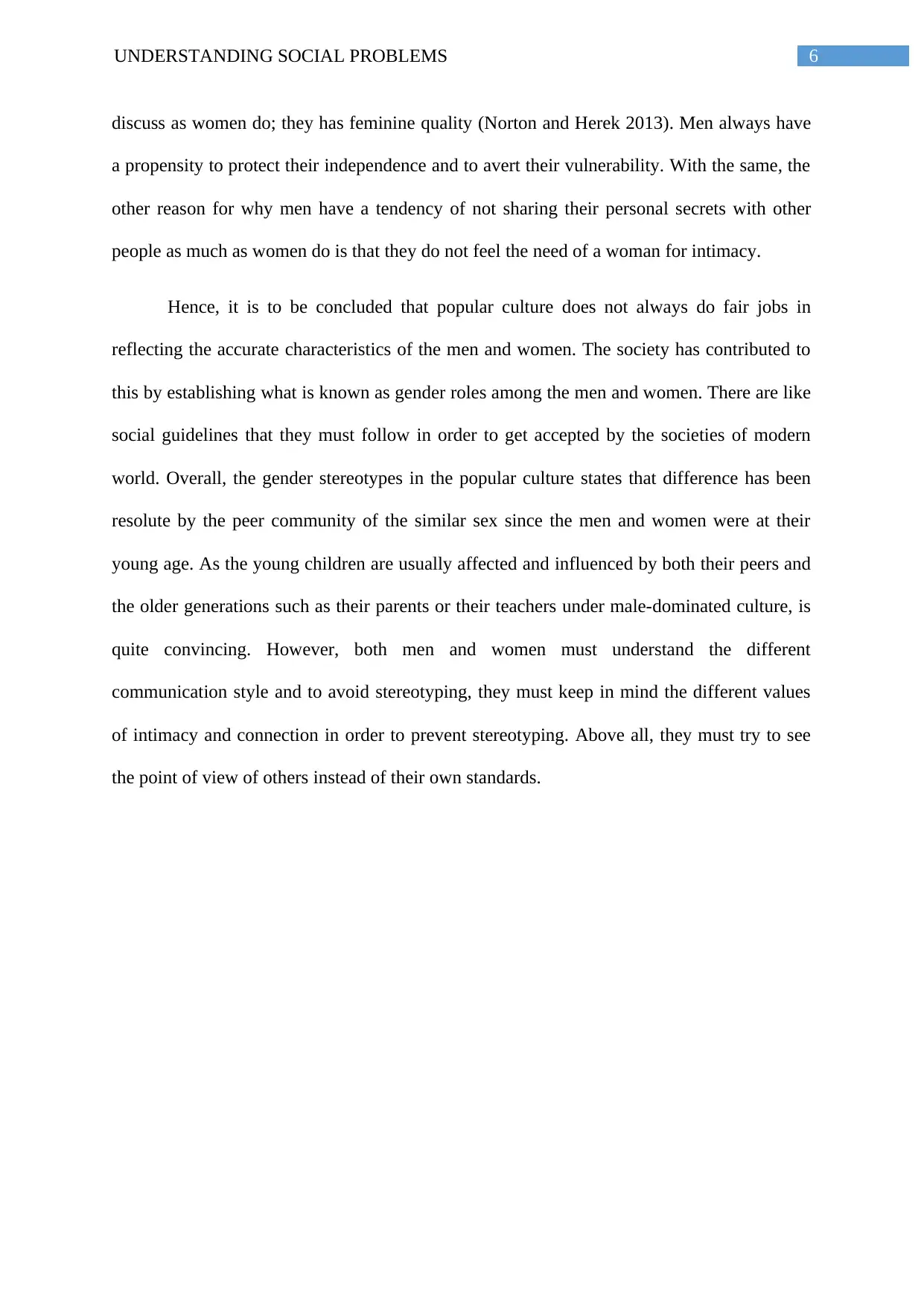
6UNDERSTANDING SOCIAL PROBLEMS
discuss as women do; they has feminine quality (Norton and Herek 2013). Men always have
a propensity to protect their independence and to avert their vulnerability. With the same, the
other reason for why men have a tendency of not sharing their personal secrets with other
people as much as women do is that they do not feel the need of a woman for intimacy.
Hence, it is to be concluded that popular culture does not always do fair jobs in
reflecting the accurate characteristics of the men and women. The society has contributed to
this by establishing what is known as gender roles among the men and women. There are like
social guidelines that they must follow in order to get accepted by the societies of modern
world. Overall, the gender stereotypes in the popular culture states that difference has been
resolute by the peer community of the similar sex since the men and women were at their
young age. As the young children are usually affected and influenced by both their peers and
the older generations such as their parents or their teachers under male-dominated culture, is
quite convincing. However, both men and women must understand the different
communication style and to avoid stereotyping, they must keep in mind the different values
of intimacy and connection in order to prevent stereotyping. Above all, they must try to see
the point of view of others instead of their own standards.
discuss as women do; they has feminine quality (Norton and Herek 2013). Men always have
a propensity to protect their independence and to avert their vulnerability. With the same, the
other reason for why men have a tendency of not sharing their personal secrets with other
people as much as women do is that they do not feel the need of a woman for intimacy.
Hence, it is to be concluded that popular culture does not always do fair jobs in
reflecting the accurate characteristics of the men and women. The society has contributed to
this by establishing what is known as gender roles among the men and women. There are like
social guidelines that they must follow in order to get accepted by the societies of modern
world. Overall, the gender stereotypes in the popular culture states that difference has been
resolute by the peer community of the similar sex since the men and women were at their
young age. As the young children are usually affected and influenced by both their peers and
the older generations such as their parents or their teachers under male-dominated culture, is
quite convincing. However, both men and women must understand the different
communication style and to avoid stereotyping, they must keep in mind the different values
of intimacy and connection in order to prevent stereotyping. Above all, they must try to see
the point of view of others instead of their own standards.
Paraphrase This Document
Need a fresh take? Get an instant paraphrase of this document with our AI Paraphraser
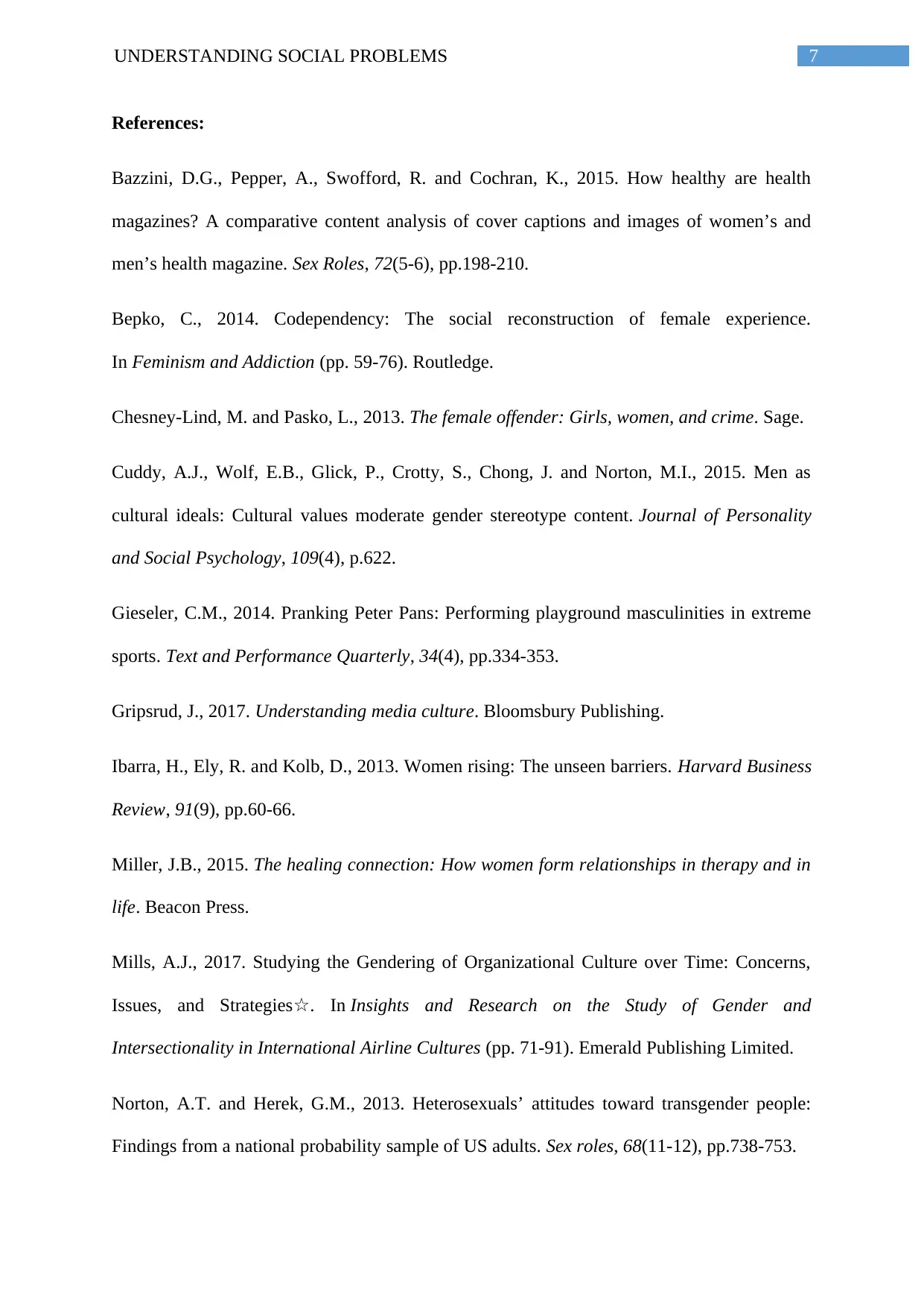
7UNDERSTANDING SOCIAL PROBLEMS
References:
Bazzini, D.G., Pepper, A., Swofford, R. and Cochran, K., 2015. How healthy are health
magazines? A comparative content analysis of cover captions and images of women’s and
men’s health magazine. Sex Roles, 72(5-6), pp.198-210.
Bepko, C., 2014. Codependency: The social reconstruction of female experience.
In Feminism and Addiction (pp. 59-76). Routledge.
Chesney-Lind, M. and Pasko, L., 2013. The female offender: Girls, women, and crime. Sage.
Cuddy, A.J., Wolf, E.B., Glick, P., Crotty, S., Chong, J. and Norton, M.I., 2015. Men as
cultural ideals: Cultural values moderate gender stereotype content. Journal of Personality
and Social Psychology, 109(4), p.622.
Gieseler, C.M., 2014. Pranking Peter Pans: Performing playground masculinities in extreme
sports. Text and Performance Quarterly, 34(4), pp.334-353.
Gripsrud, J., 2017. Understanding media culture. Bloomsbury Publishing.
Ibarra, H., Ely, R. and Kolb, D., 2013. Women rising: The unseen barriers. Harvard Business
Review, 91(9), pp.60-66.
Miller, J.B., 2015. The healing connection: How women form relationships in therapy and in
life. Beacon Press.
Mills, A.J., 2017. Studying the Gendering of Organizational Culture over Time: Concerns,
Issues, and Strategies☆. In Insights and Research on the Study of Gender and
Intersectionality in International Airline Cultures (pp. 71-91). Emerald Publishing Limited.
Norton, A.T. and Herek, G.M., 2013. Heterosexuals’ attitudes toward transgender people:
Findings from a national probability sample of US adults. Sex roles, 68(11-12), pp.738-753.
References:
Bazzini, D.G., Pepper, A., Swofford, R. and Cochran, K., 2015. How healthy are health
magazines? A comparative content analysis of cover captions and images of women’s and
men’s health magazine. Sex Roles, 72(5-6), pp.198-210.
Bepko, C., 2014. Codependency: The social reconstruction of female experience.
In Feminism and Addiction (pp. 59-76). Routledge.
Chesney-Lind, M. and Pasko, L., 2013. The female offender: Girls, women, and crime. Sage.
Cuddy, A.J., Wolf, E.B., Glick, P., Crotty, S., Chong, J. and Norton, M.I., 2015. Men as
cultural ideals: Cultural values moderate gender stereotype content. Journal of Personality
and Social Psychology, 109(4), p.622.
Gieseler, C.M., 2014. Pranking Peter Pans: Performing playground masculinities in extreme
sports. Text and Performance Quarterly, 34(4), pp.334-353.
Gripsrud, J., 2017. Understanding media culture. Bloomsbury Publishing.
Ibarra, H., Ely, R. and Kolb, D., 2013. Women rising: The unseen barriers. Harvard Business
Review, 91(9), pp.60-66.
Miller, J.B., 2015. The healing connection: How women form relationships in therapy and in
life. Beacon Press.
Mills, A.J., 2017. Studying the Gendering of Organizational Culture over Time: Concerns,
Issues, and Strategies☆. In Insights and Research on the Study of Gender and
Intersectionality in International Airline Cultures (pp. 71-91). Emerald Publishing Limited.
Norton, A.T. and Herek, G.M., 2013. Heterosexuals’ attitudes toward transgender people:
Findings from a national probability sample of US adults. Sex roles, 68(11-12), pp.738-753.
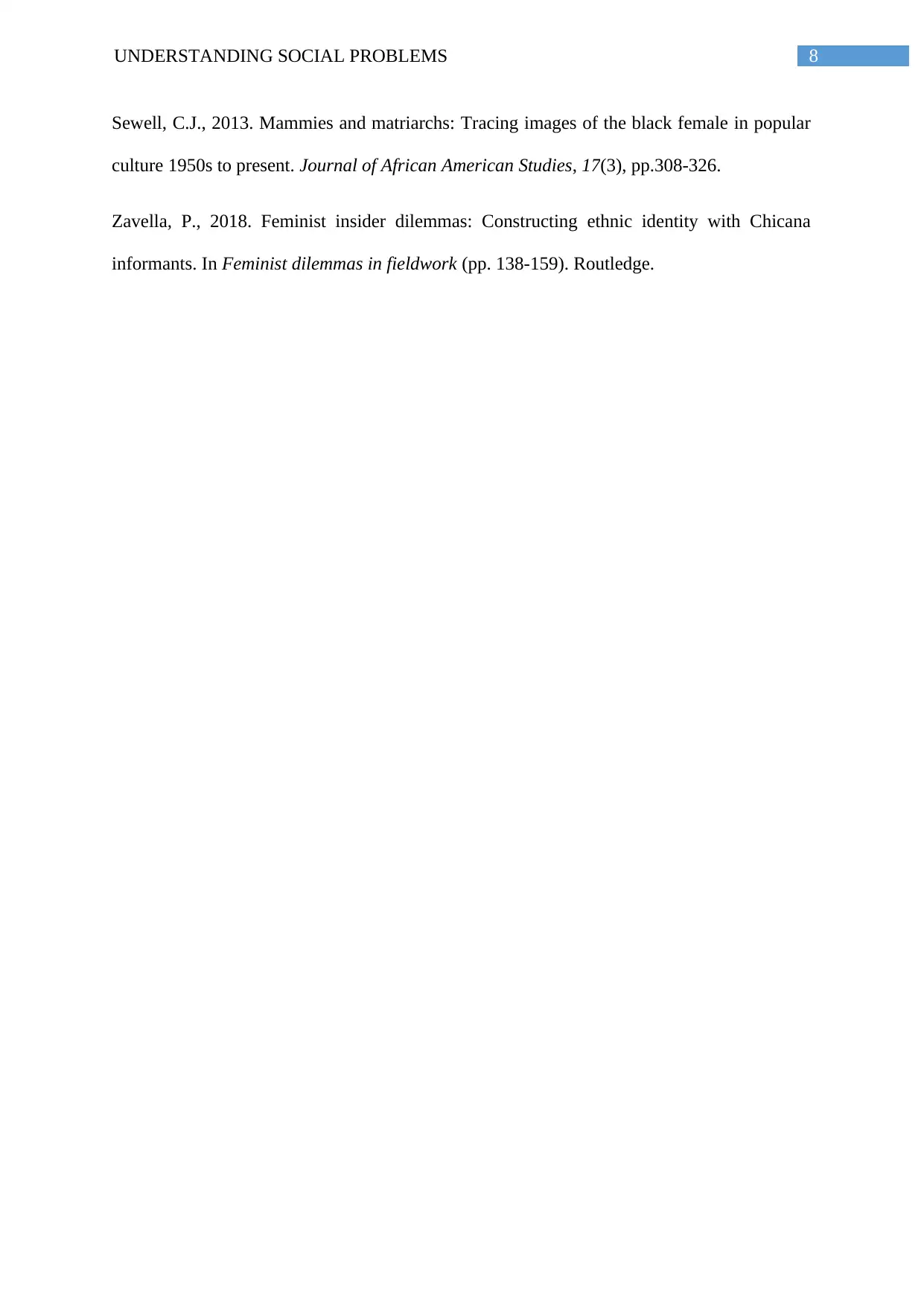
8UNDERSTANDING SOCIAL PROBLEMS
Sewell, C.J., 2013. Mammies and matriarchs: Tracing images of the black female in popular
culture 1950s to present. Journal of African American Studies, 17(3), pp.308-326.
Zavella, P., 2018. Feminist insider dilemmas: Constructing ethnic identity with Chicana
informants. In Feminist dilemmas in fieldwork (pp. 138-159). Routledge.
Sewell, C.J., 2013. Mammies and matriarchs: Tracing images of the black female in popular
culture 1950s to present. Journal of African American Studies, 17(3), pp.308-326.
Zavella, P., 2018. Feminist insider dilemmas: Constructing ethnic identity with Chicana
informants. In Feminist dilemmas in fieldwork (pp. 138-159). Routledge.
⊘ This is a preview!⊘
Do you want full access?
Subscribe today to unlock all pages.

Trusted by 1+ million students worldwide
1 out of 9
Related Documents
Your All-in-One AI-Powered Toolkit for Academic Success.
+13062052269
info@desklib.com
Available 24*7 on WhatsApp / Email
![[object Object]](/_next/static/media/star-bottom.7253800d.svg)
Unlock your academic potential
Copyright © 2020–2025 A2Z Services. All Rights Reserved. Developed and managed by ZUCOL.





